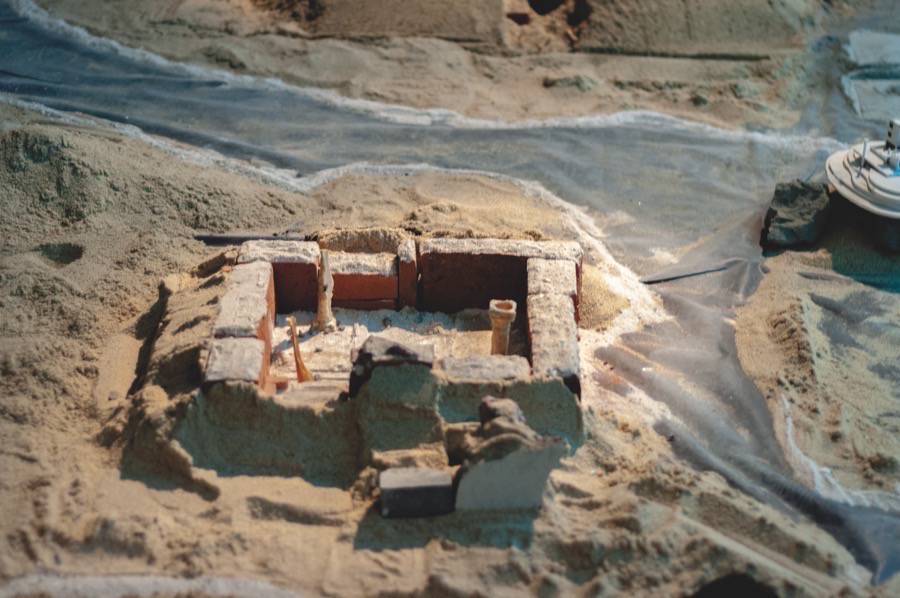

By Gabriela de Laurentiis
“Everyone knows which cities were made to be destroyed.” These words stuck in my thoughts about the Circa work, edited by artist Anna Bella Geiger at the 16th Istanbul Biennial. The installation brings semantic and poetic meanings of an uncertain time, something for which there is no p recision of dates. Geiger produces an installation combining ephemeral constructions – made of sand, dry cement, earth – and prefabricated objects – such as a small replica of a Bauhaus house, a small train and pieces of glass that form a small pool. There is also a video built in conversation with Philip Glass’s Akhnaten opera.
The first installation of the work was performed as part of the Breathing Project (2006), at the Eva Klabin Foundation Museum, Rio de Janeiro, curated by Marcio Doctors. The choice of materials makes the work gain, with each assembly, unique characteristics. Among the specifics of the Istanbul mount are the white sand roads, inspired by the area views during the wake of Brazil to Turkey: “I noticed these roads in the middle of the desert. This road layout I had not done in any of the previous installations”, says Anna Bella Geiger.
Poetic elaborations from maps, architectures and spatialities are striking in Anna Bella Geiger’s artistic practice. In Circa these discussions take the form of a fantastic / ghostly city with temporal-spatial configurations detached from linear periodizations. For researcher and artist Ana Hortides – who has done a series of montages of the work, including the Istanbul Biennale – “Circa presents a kind of city that mixes, at first glance, different cultures and temporal spaces in ruins, or apparently , close to collapse ”.

The fragility of matter and the crumbling architectural constructions bring a sense of destruction, of territory being devastated. Geiger recalls that Circa’s first building was shrouded in the imagery of the Occupation of Iraq – which had been going on for three years – thickening through words the feelings of devastation wrought by the installation’s forms and materials.
The senses of the work expand in the situation of the Istanbul Biennale, curated by Nicolas Bourriaud, entitled The Seventh Continent. The term refers to a floating area in the Pacific Ocean of three million four hundred thousand square kilometers composed of seven million tons of plastic.
The impacts of human action on catastrophic dimensions in the framework of the Anthropocene – concept by researchers Paul Crutzen and Eugene Stoermer to call the geological age the effect of human activity on the globe – or the Capitalocene – as proposed by Andreas Malm, are underway at the Istanbul Biennale. politically these contemporary issues. The wars motivated by economic interests interspersed with religious problems, the impacts on basic resource infrastructures and the lifestyles of various regions of the planet make up the contemporary world. Circa brings this dimension.
The work was assembled in the projected building Emre Arolat which from 2020 will house the Istanbul Museum of Painting and Sculpture. There is also screened, among other works, the video O Peixe (2016) by Alagoas Jonathas de Andrade. Entering the building is impossible to disregard the views from the numerous windows. Of the vast majority of them what can be seen abroad are workers, scaffolding and unfinished structures. A construction site is formed in the midst of the waters of the Bosphorus, buildings and mosques, which make up the landscape of the region, which is undergoing a major redevelopment project.
Architect and artist Laura Nakel says that “the transformation of former Warehouse No. 5 on the edge of the Karaköy region into a museum shares features with recent major developments such as Puerto Madero in Buenos Aires, Wonder Harbor in Rio de Janeiro and V&A Waterfront in Cape Town ”.

Circa’s production in this place has the effect of questioning the relations between the outside and the Museum. The ruined city of Geiger makes one think of Istanbul’s buildings and vice versa. As Geiger recalls, the work deals with “questions concerning spirituality, memory, history, and stories in a dimension of an extended space-time.” In the city of Istanbul all these questions resurface in the very structuring of urban space, sometimes in catastrophic dimensions. Nakel recalls that in the Museum region there is “a process that begins in the 1990s, in which galleries and art collectives occupy the old abandoned warehouses, initiating a process of gentrification in the region, intensified with the arrival of large private investors”.
In the crossing between continents, however, Circa’s buildings gain another layer of possibility: hopeful transformation. For Hortides “the inclusion of a wet, living and seemingly fertile land makes the passage of time at the Istanbul Biennale assembly a little more hopeful for things to come, a harbinger of construction and transformation, despite disasters”. Anna Bella Geiger with her crosses through uncertain times makes one imagine multiple and agonistic spaces, elaborating a vibrant and alive poetics.
¹ Bourriaud, N. “The Seteventh Continet: These Upon Art In The Age Of Global Warming”. In Seventh Continent. Catálogo da 16ª Bienal de Istambul. Istambul, 2019. P.47.
* Gabriela De Laurentiis is a visual artist and researcher. She is the author of the book Louise Bourgeois and feminist ways of creating. She holds a degree in Social Sciences from PUC-SP and a master’s degree from the Department of Cultural History at UNICAMP. She is currently a doctoral student at FAU-USP, with research in Anna Bella Geiger, who writes for this issue.










